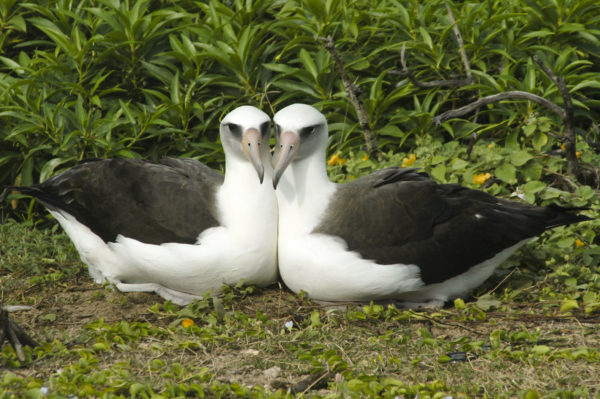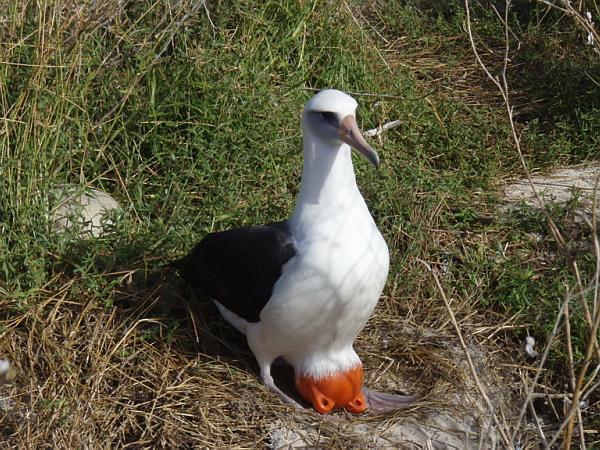Published in the Ocean Watch column, Honolulu Star-Advertiser © Susan Scott
Friday, May 30, 2008
In the animal kingdom, when the sex ratio of a species gets skewed, queer things happen.
If there’s a shortage of females, as is the current situation of Hawaiian monk seals, some males get frustrated and, in their desperation to mate, defeat the purpose by killing females and their offspring.
But a shortage of males is a different story. In one Hawaii species, females don’t wait for male mates to carry out their reproductive duty. Single females pair up, find a sperm donor and then raise offspring together.
This is the surprising case in one-third of the Laysan albatrosses nesting at Oahu’s Kaena Point Natural Area Reserve.
In Wednesday’s online edition of Biology Letters, researchers report that five years ago at Kaena Point, they noticed an unusual number of nests contained two eggs. Each female albatross lays only one egg per season — if the egg is lost, she does not lay a second. Two eggs in a nest, therefore, means two females laid them.
Because you can’t tell male and female albatrosses apart by sight, the researchers collected feathers from the couples in the two-egg nests for DNA sexing. The data revealed that female-female pairs occupied 31 percent of the nests.

A female-female Laysan albatross pair at Kaena Point. Photo credit: Eric VanderWerf of Pacific Rim Conservation
The probable reason for this, the researchers say, is that the Kaena Point albatross colony is growing due to immigration, and it’s usually the females who set out as pioneers. Kaena Point has 1.5 female albatrosses for every male.
Since it takes two birds to raise a chick, some single females hook up with another single female. Both birds lay an egg but incubate only one. The other eventually rolls out of the nest or gets buried in the soil.
Which egg lives is pure luck, and the females don’t know the difference. These birds’ urge to hatch an egg is so strong they’ll sit on just about anything — fishing floats, rocks, golf balls. One biologist saw an albatross trying to incubate a volleyball.

It’s a Buoy!
Photo Credit: Susan Scott
Some female pairs commit to their relationships long term. At Kaena Point, half the female pairs stayed together during the four-year study. On Kauai, several female couples have been together for at least eight years, and one pair has remained committed for 19 years.
When the lab work is complete, researchers expect the percentage of female couples at Kauai’s Kilauea Point to be similar to Oahu’s Kaena Point.
Getting their eggs fertilized is no problem for single females. Albatrosses might be the poster birds for lifelong monogamy, but some things in biology are universal: Mated males cheat.
The single females don’t seem to care who donates the sperm. Genetic testing revealed that no male fathered more than three of the chicks during the four-year Kaena Point study. Also, male sperm donors nested at various distances from the female pairs, meaning the fathers weren’t simply the nearest neighbors.
The sexing study continues at Midway, Laysan and French Frigate Shoals to see how prevalent female couples are in Hawaii’s Northwest Chain.
In the meantime, things are going well at Kaena Point. Of 50 nests this year, 27 chicks hatched, four from female pairs.
Same-sex couples raising offspring might not seem natural to some people, but it doesn’t get more natural than this. These magnificent seabirds have shown us survival of the fittest at its finest.